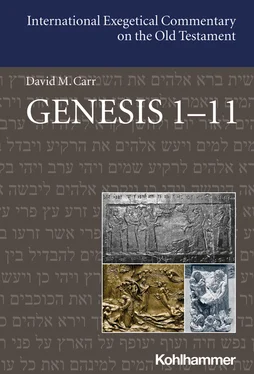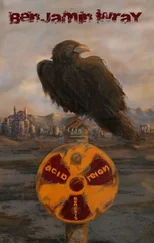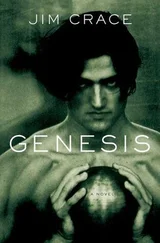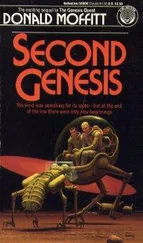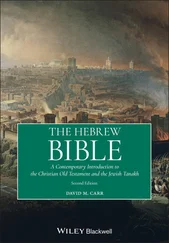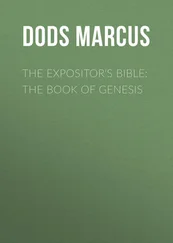David M. Carr - Genesis 1-11
Здесь есть возможность читать онлайн «David M. Carr - Genesis 1-11» — ознакомительный отрывок электронной книги совершенно бесплатно, а после прочтения отрывка купить полную версию. В некоторых случаях можно слушать аудио, скачать через торрент в формате fb2 и присутствует краткое содержание. Жанр: unrecognised, на английском языке. Описание произведения, (предисловие) а так же отзывы посетителей доступны на портале библиотеки ЛибКат.
- Название:Genesis 1-11
- Автор:
- Жанр:
- Год:неизвестен
- ISBN:нет данных
- Рейтинг книги:4 / 5. Голосов: 1
-
Избранное:Добавить в избранное
- Отзывы:
-
Ваша оценка:
- 80
- 1
- 2
- 3
- 4
- 5
Genesis 1-11: краткое содержание, описание и аннотация
Предлагаем к чтению аннотацию, описание, краткое содержание или предисловие (зависит от того, что написал сам автор книги «Genesis 1-11»). Если вы не нашли необходимую информацию о книге — напишите в комментариях, мы постараемся отыскать её.
Genesis 1-11 — читать онлайн ознакомительный отрывок
Ниже представлен текст книги, разбитый по страницам. Система сохранения места последней прочитанной страницы, позволяет с удобством читать онлайн бесплатно книгу «Genesis 1-11», без необходимости каждый раз заново искать на чём Вы остановились. Поставьте закладку, и сможете в любой момент перейти на страницу, на которой закончили чтение.
Интервал:
Закладка:
Before exploring Gen 1:26–27 more, it should be noted at the outset that this text is not as specific about its implications as many of its interpreters would have it be. For example, there has long been a major emphasis, particularly characteristic of traditional Christian theological interpretation of the text, to stress that Gen 1:26–27 does not imply any physical resemblance between divine beings and humans. 83As will be argued below, this approach is only true in terms of what the text emphasizes. However much Gen 1:26–27 does presuppose some physical resemblance between the bodies of human beings and a God that is imagined (as in other biblical and many other Near Eastern texts) as having human form, the text is much more focused on how this physical resemblance to God is a reflection of the destiny of humans to exercise godlike rule over creation. 84
That said, it should be emphasized that the text does imply a physical resemblance between humans and God, even as it qualifies just how much humans are thought to be like God (more on this below). Indeed, the text privileges (in Gen 1:26 and 1:27) a term for humans as divine replicas of god(s), צלם, which is routinely used for three-dimensional statues, including cult statues of deities, the latter of which were typically given human-like form in the ancient Near East, including the Levant. 85Moreover, the Hebrew Bible itself features numerous descriptions of God as having human(like) body parts, doing human things, and sometimes even being so similar in human form as to be confused with human beings (e.g., Gen 18:1–15; 32:23–33 [ET 32:22–32]). 86All this would suggest that the description of God’s call to “let us make humans as our image [צלם]” and subsequent act “and God created humans as the/an image of God” includes as one of its implications an actual physical resemblance between divine beings/God and humanity even if other meanings are encompassed and even prioritized in the rest of the text. And P will then later describe the first human, Adam, passing this physical resemblance on to his son (5:1–3). 87
This concept of human creation “as the image of God in Gen 1:26–27 has been further illuminated through consideration of ancient Near Eastern conceptuality surrounding cultic images of God on the one hand and kings as images of deities on the other. Especially if one judges that Gen 1 was written in the Babylonian diaspora, we have good reason to believe the author and his community were familiar with Mesopotamian practices surrounding cult images of deities. These practices included the manufacture of images of gods that were (usually) in human form, the cultic activation of these images through rituals that denied the human origins of the images and attributed their making to divine intervention, and overall worship and care for such images as primary ways in which the gods made themselves physically accessible in the earthly world. 88Already the Deuteronomistic History and Ezekiel include some critique of these practices and ideas surrounding cult images. Nevertheless, the late exilic prophetic material of Second Isaiah represents the most detailed engagement with Mesopotamian conceptuality surrounding divine images. For example, Isa 44:9–20 directly challenges the idea that gods, rather than humans, were the real manufacturers of cult images. 89
Likely crafted within a similar Mesopotamian diasporic context, Gen 1:26–27 represents a creative critique and alternative to Mesopotamian (and other) theology around cult images. Rather than endorsing (or critiquing, so Isa 44:9–20) human-made clay (often) anthropomorphic statues as images of God, it depicts actual humans—long recognized as divinely made in older cosmogonic traditions—as the truly God-made divine images. 90In this sense, Gen 1 plays on the widespread phenomenon of depicting God in human form, present in Israel and many other cultures as well. Rather than understanding the correspondence between human form and human pictures of god as a result of people’s projection of their own form on god(s), this text proposes that the one God who created the universe projected his form on humans. In sum, Gen 1:26–27 suggests that God had (what we call) ‘human’ form first.
At the same time, Gen 1:26–27 qualifies the similarity of humans to their divine creator in ways foreign to Near Eastern cult image theology. Where Mesopotamian and other texts stressed the strong links of cult images with the gods they depicted, even to the point of speaking of cult images as if they were identical to the gods they represented, Gen 1:26 suggests, at least initially, that God made humans as images of God’s council in general (“let us make humans as our image”), and it adds an additional specification, “similar to our likeness,” that both claims (physical) similarity and also establishes some distance between humans and the divinity that they resemble. 91The term translated here as “likeness,” דמות, elsewhere is primarily attested in Ezekiel’s (exilic) prophecy as a term for quite approximate, and difficult-to-specify similarity, a sort of image that is otherwise indescribable (Ezek 8:2; see also 1:10, 13, 16, 22, 26, 28; 10:1, 10). 92Moreover, the preposition כ (here “similar to”) asserts both similarity and separation of its object from that with which it is being compared. 93Anything that is merely similar to something else is also somehow different. Thus, within the charged diasporic context surrounding divine image practices, the crucial divine speech in Gen 1:26 states God’s intent to make humans as image-statues of divine beings in general, but also asserts, at least initially, that these statues will only be similar, in a difficult-to-quantify way (דמות) to the divinity they represent. Though Gen 1 singles humans out from other creatures as made by God as God’s image, they are also not identical replicas to God in the way that plants or other animals reproduce “according to their kind(s).”
Just as important, if not more so, for understanding the associations of the divine image language in Gen 1:26–27 is ancient Near Eastern ideology surrounding kings as images of gods, particularly insofar as the power exercised by kings mirrored and served as an extension of the power attributed to deities. For example, the Tukulti-Ninurta Epic speaks of how the Assyrian king “is the very image of Enlil” and similar statements about the king are found in a handful of later Neo-Assyrian and Neo-Babylonian letters. This theme is more common in Egyptian literature, starting in the Middle Kingdom period and expanding during the New Kingdom period in particular. 94For example, an inscription for Amenophis/Amenhotep III from the 14th century BCE (New Kingdom) has the god, Amun-Re-Kamutef, declare to the king:
For you are my beloved son, who came out from my love, my image that I put on earth. I set you in peace to rule the land, in which you wipe out the heads of all the foreign lands. 95
For now it is important to recognize that these ideas of the king as an “image of [deity x ]” occurred in cultures with cult images and were more or less linked with those cultures’ ideas of cult images as “images of [deity x ].” In the case of the Tukulti-Ninurta Epic, the king is described as the “cult image” ( ṣalmu ) of the high God, Enlil, using language of birth and manufacture typical of Mesopotamian cult image theology. 96Overall, the king as an animate and powerful “image of god” along with cult statues in Mesopotamia and other parts of the ancient Near East stood as the two chief ways in which otherwise unseen deities were understood to make themselves physically available in the earthly world. 97
Genesis 1 connects initially and repeatedly with these royal ideological strands of ancient Near Eastern image theology. This starts in God’s Gen 1:26 speech, when God says, “let us create humans as our image … so that they may rule the fish of the sea, the birds of the sky, the domesticated animals and all the earth, and all the creeping animals that creep on the earth.” Thus, it is as godlike rulers that humans stand vis-à-vis the animal world, not as cult statues representing God to them. 98At the same time, Gen 1 diverges in significant ways from traditions about the king as image of God. To start, Gen 1:26–27 now depicts all of humanity—not just the king—as bearing this divine image conferring rulership, implicitly royalizing all of humanity. 99Moreover, the scope of rule has shifted. Rather than a king ruling other humans, here humans rule all other creatures of God’s creation, even the fish of the sea and the birds of the air. There is no other obvious set of candidates to be ruled by all of humanity than these non-human creatures in the rest of creation. 100
Читать дальшеИнтервал:
Закладка:
Похожие книги на «Genesis 1-11»
Представляем Вашему вниманию похожие книги на «Genesis 1-11» списком для выбора. Мы отобрали схожую по названию и смыслу литературу в надежде предоставить читателям больше вариантов отыскать новые, интересные, ещё непрочитанные произведения.
Обсуждение, отзывы о книге «Genesis 1-11» и просто собственные мнения читателей. Оставьте ваши комментарии, напишите, что Вы думаете о произведении, его смысле или главных героях. Укажите что конкретно понравилось, а что нет, и почему Вы так считаете.
